Gareth Evans The Raid 2
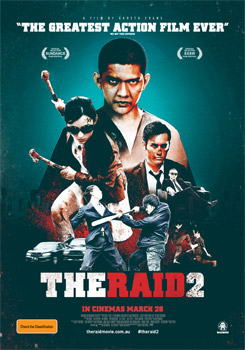
The Raid 2
Cast: Iko Uwais, Julie Estelle, Yayan Ruhian
Director: Gareth Evans
Genre: Action, Crime, Drama
Rated: MA
Running Time: 148 minutes
Synopsis: He thought it was over. After fighting his way out of a building filled with gangsters and madmen - a fight that left the bodies of police and gangsters alike piled in the halls - rookie Jakarta cop Rama thought it was done and he could resume a normal life. He couldn't have been more wrong.
Formidable though they may have been, Rama's opponents in that fateful building were nothing more than small fish swimming in a pond much larger than he ever dreamed possible. And his triumph over the small fry has attracted the attention of the predators farther up the food chain. His family at risk, Rama has only one choice to protect his infant son and wife: He must go undercover to enter the criminal underworld himself and climb through the hierarchy of competing forces until it leads him to the corrupt politicians and police pulling the strings at the top of the heap.
And so Rama begins a new odyssey of violence, a journey that will force him to set aside his own life and history and take on a new identity as the violent offender "Yuda." In prison he must gain the confidence of Uco - the son of a prominent gang kingpin - to join the gang himself, laying his own life on the line in a desperate all-or-nothing gambit to bring the whole rotten enterprise to an end.
The Raid 2
Release Date: March 28th, 2014
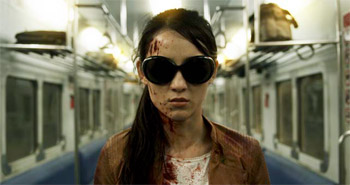 About the Production
About the Production
In 2009, after the successful release of Merantau, Evans wrote an ambitious action drama, Berandal (Delinquent / English translation). The script contained substantial action scenes and complicated stunts that required a much bigger production than Merantau. Evans and Barack spent the whole year of 2010 searching for funding and technical support fit for the ambitious project.
Unfortunately, they struggled and were forced to put the project on hold while Merantau Films moved forward with its second feature film, The Raid: Redemption, produced in 2011. The Raid: Redemption was received positively from both Indonesian and international audiences in 2012. After The Raid: Redemption's success, Gareth Evans and Barack- Evans were convinced that there was potential for a RAID franchise.
Gareth Evans began revisiting Berandal's script to determine if it could be adapted as a sequel to The Raid. (A close associate from XYZ Films, Nate Bolotin, Todd Brown, Nick Spicer and Aram Tertzakian kept a close discussion and adaptation of Berandal into The Raid 2). Evans worked on a multiple drafts, tweaking the story line, characters and parts of the plot and completed it in the summer of 2012. The revised script, with changes made to some of the supporting roles, gave Evans the opportunity to cast Japanese actors as members of the opposite gang: Kenichi Endo as M. Goto, the mafia boss, Ryuhei Matsuda as Kenichi, his son, and Kazuki Kitamura as his right hand man.
Preproduction for The Raid 2 began in Jakarta in the fall of 2012. With the revised script in hand, Evans, Uwais and Ruhian began making adjustments to the action choreography originally developed by Uwais and Ruhian in 2010: 'Once the revised script was completed, we started working on adjusting the action choreography to fit the new script. Gareth asked for a lot more fight scenes to be added and the technical level of the fights was also increased, especially for the Hammer Girl part. Her fight choreography was much less complex in the original script" (Yayan Ruhian)
Before preproduction on The Raid 2, Evans shot a short feature titled OUTCALL starring Julie Estelle. Julie Estelle's role in the film required a small fight scene. After seeing her performance, Gareth Evans saw Julie Estelle as a potential candidate for Hammer Girl. Julie Estelle was among the candidates who auditioned for the role. Candidates were given two days to learn and rehearse the choreography imagined by Uwais and Ruhian. They performed on the third day. Even though Julie Estelle did not have any martial arts background, her performance stunned Gareth Evans s, Uwais and Ruhian. Julie Estelle proved able to not only fight well, but perform her scenes with credibility. She was exactly what Evans was looking for.
One of the most memorable scenes in the film (and the one Gareth Evans was most excited about) features Hammer Girl - a pretty and fashionable girl looking like a pop icon - using two hammers to eliminate a gang of men as she slowly reaches towards her target in a subway train.
Since his debut as the lead actor in Merantau (Yudha) and in The Raid: Redemption (Rama), Uwais has always played a righteous ideal hero. When Evans wrote The Raid 2 he wanted to challenge Uwais by creating a hero who has lost track of himself and as a result shows a darker side. Rama manages to escape from the chaos with the help of his brother. After a gang member kills his brother, Rama develops a strong sense of revenge. He loses control when he goes undercover into the dark world of gangsters. Rama, once a hero with strong moral values, slowly becomes violent. Rama is also now a married father of a young boy. Embodying a character with such a complex story was challenging for Uwais: 'When I make a film, I don't really want to repeat what I have already done in my previous films, I like to keep pushing the challenge bar in many ways and present a fresh product" (Gareth Evans)
In The Raid: Redemption, the leading and supporting roles were somewhat limited, and the storyline rather simple. Gareth Evans wanted The Raid: Redemption to be an equivalent of a roller coaster experience in cinema. In The Raid 2, Gareth Evans wanted to create a much more complex film, developing subplots and multiple supporting characters. He strove to make the new characters as compelling as possible, even those with limited onscreen presence. None are there to merely support the principal casts but are equally important and. For instance, Hammer Girl and Baseball Bat Man are both written as characters that don't have any lines of dialog. Yet they each have one amazing action scene to themselves. The two characters are memorable on the strength of these scenes alone. The film also features car stunts, a new type of filmmaking for Evans.
The car stunts were coordinated by the Hong Kong stunt team, under the supervision of Bruce Law. Introduced by common friend Mike Leeder, Gareth Evans and Bruce Law met in Jakarta in December 2012 and discussed Gareth Evans's ideas at length. After finding common ground, they worked together on designing the stunts, which included painstakingly planning details such as car types and locations. It was the first time a car stunt sequence was filmed in Indonesia, so it was quite a challenge working with local authorities.
Aria Prayogi and Fajar Yuskemal had already collaborated with Merantau Films for Merantau (2009) and The Raid: Redemption's (2011) score. However, for The Raid: Redemption's U.S. release, the score was done by Mike Shinoda (Linkin Park) and Joe Trapanese. For The Raid 2, Gareth wanted to avoid having two versions of the score. He set up a platform where Aria and Fajar could collaborate with foreign artists. Once the The Raid 2's production was announced, Joe Trapanese showed interest in joining the project.
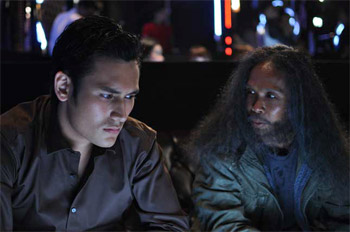 The Raid 2 – Locations
The Raid 2 – Locations
Since it is about life outside of the drug lord's building, The Raid 2 called for a variety of filming locations: office buildings, restaurants, nightclubs, alleyways, warehouses, prisons, public roads, etc. The locations also had to match very specific technical requirements (especially when use of dolly track, jimmy jib, cranes etc. was required).
Locations were a mix of real places and studio sets. Real locations included commercial malls such as the Plaza Indonesia (Bistro Baron restaurant/Prakoso meeting his wife, double escalator/Ryuichi's shooting), the Grand Indonesia mall (bathroom where Uco washes his hands covered in blood), the Grand Hyatt Hotel (C's restaurant), and a warehouse in Tambung (final fight scene). The following are several other locations that had specific requirements.
Car Scenes
In The Raid 2, Gareth Evans wanted to explore car stunts, a new territory for him. With support from Hong Kong's leading car stunt expert, Bruce Law, the stunts were brilliantly executed in Jakarta. After Gareth Evans presented him with his ideas, Law came up with suggestions for improvements: 'Car chases – I had never done that before. I'm very grateful that we had Bruce Law's team to help us achieve what we wanted to achieve. It was fascinating to see what we created during preparation come to life. It wasn't an easy process, though. We did day shoots with permits, closing off roads. We'd lose about 50% of shooting hours, but rewards were high" (Evans)
Even though numerous films are shot in Indonesia every year, action movies are not common. It was challenging to obtain permits in order to block roads. Gareth Evans's plan for the majority of the car scenes were all daytime shoot with a city center surrounding view. For car stunts, the production team needed to have three to four main roads, but the location manager managed to secure six locations in Jakarta:
SCBD (business district)
Kemayoran (partly business and residential district)
Senayan main road )
Sunter Bypass (main connecting road from central Jakarta to Sunter suburb)
Little Tokyo area (commercial area with a lot of Japanese bars and restaurants)
Blok M Bus terminal (one of the main bus terminals in Jakarta)
The most difficult part was to get each shot as quickly as possible, since roads could only be closed for a few hours. The roads required for majority of the car stunts had to have a minimum width of three lanes, which was not easy to find. The scenes in SCBD, a bustling business district, were particularly tricky since the permit only allowed the crew to shoot on weekends. Other scenes were also shot in two nearby tunnels: for the scene where Bunawar is driving while trying to get hold of Rama and for the scene where Rama jumps off the back of an SUV on to a Sedan while the two cars are in motion.
For the scene where Eka is chasing Rama's kidnappers, Oka Antara received special training from Law and his team.
The car chase action probably was the biggest challenge since there was no real practice for it. So it's important to understand the sequence chronologically first. What's good is that Gareth Evans wants us to show the pain and impact after the bump, crash, window smash, and shoot out. It's good for the audience when they see it. And then there were shots and sequences that I had to do myself. It's challenging because it requires driving instinct and team work. It frustrates us when we didn't get the shot we wanted. And we're lucky to have Bruce and his team on our side to keep us safe (Oka Antara)
The production team was also under a lot of pressure for the shooting of the Sunter Bypass scene. The road had to stay open to the public since no alternative route exists. This required strict crowd control and re-opening the road as soon as the scene was shot.
The area of Senayan is home to the Indonesian national television channel (TVRI), the national sports stadium (istora senayan), the Jakarta Convention Center, the Ministry of Youth and Sports and a luxurious 5-star hotel. Along the main drag are over sixty small businesses which would have to close during shootings. The location manager therefore had to negotiate with the local shop owners. The road could only be closed for two hours at most. Even though the location was challenging, it was ideal for the scene in which a speeding car crashes into a bus terminal. The bus terminal was built over a week, only to be destroyed the day of the shoot. Measuring ten meters high, construction took one week and was destroyed instantly in one shot on the day of filming.
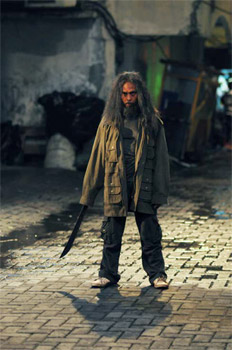 For the Little Tokyo and Blok M bus locations, the crowd was the difficulty, as Little Tokyo is in the middle of a busy shopping area. The street where the taxi scene was shot is quiet, lined by restaurants and bars that are only open at night, but maintaining a stable crowd was challenging due to the mall nearby. The Blok M Bus terminal scene required coordination with the bus terminal operational office. Since there were many buses coming in and out of the terminal, production location manager had a lot of pressure to make sure that the bus traffic didn't enter the frame when the camera was rolling. The production team was supported by local police authority in securing all locations and crowd control.
For the Little Tokyo and Blok M bus locations, the crowd was the difficulty, as Little Tokyo is in the middle of a busy shopping area. The street where the taxi scene was shot is quiet, lined by restaurants and bars that are only open at night, but maintaining a stable crowd was challenging due to the mall nearby. The Blok M Bus terminal scene required coordination with the bus terminal operational office. Since there were many buses coming in and out of the terminal, production location manager had a lot of pressure to make sure that the bus traffic didn't enter the frame when the camera was rolling. The production team was supported by local police authority in securing all locations and crowd control. 'I've always been a fan of films like Bullitt or Ronin with great car chase sequences where it's all about the mechanics of the cars, the gradual wear and tear, which is what I love. It's still playing within the parameter of reality, not seeing torn up cars still running but there's a certain realism to it also understanding of geography in order for the audience to follow where they are, where they are going, what point and what's next. When we were designing the car chase scenes, we know that we won't be able to compete with big budget films like Fast and Furious with big car chases, chaos and destruction. But what we do is try to find a way to present car stunt and car actions that fit the world of The Raid and the action that I'm doing myself. My focus on those scenes was more on what happens to the bodies inside the car: drivers, passengers when their car get hit, crashed, which gives a unique selling point to me and made it different from things what we've seen previously and then we were able to incorporate certain structural things or architectural that are identical to Indonesia – we built a bus terminal (known as bus way terminal in Indonesia) in order to smash through it , we took advantage of this to present something that's different, that gives a local appeal and exotic feel to international audience" (Gareth Evans)
Prison and Brothel Scenes
Locations for prison scenes were dissected into several different set up and locations: The scenes in Rama's prison cell, prison canteen, visitor's room and the prison toilet were shot on a set built inside an old Dutch style building called Gedung Kerta Niaga, located in Jakarta's old town. The old town, Kota Tua, is teeming with abandoned colonial style buildings. The structure's high ceilings and abandoned, dark tone created an ideal environment for the prison, and many existing parts of the building were able to be used, thereby minimising studio space rentals. The building's wide interior space made it possible to build two sets at the same time, which meant the shooting could be done in a single location, saving both time and money. The staircase leading down to the prison canteen used the building's existing structure with only minor alterations. The brothel scene, where Uco brings Rama on his first job, was also created in the Kerta Niaga building.
Before deciding to use the Kerta Niaga building for the prison sets, the production team visited several real prisons, considering them for potential use. However, after seeing many of the prison cells and prison buildings in Jakarta and its suburbs, the logistics of doing so proved unrealistic: the crew and shooting hours would have to have been too limited.
Baseball Bat Man, Father's Café and Japanese Gang Shootout Scenes The fight scene between Baseball Bat Man and several other men took place on a street near the Kerta Niaga building. The scene continues inside a nearby abandoned building. Evans particularly liked the high ceilings and wide open space with many windows allowing for plenty of natural light. The scene at the father's café and the shootout with the Japanese gang were also shot in two of the neighbouring buildings, where the bold staircase offered interesting visuals. The lift was specifically constructed by the art department to fulfill the scene's requirement.
Prison courtyard
Evans had a specific image in mind for the prison courtyard scene. He wanted a large open yard, common in American prisons. Most Indonesian prison structures are not laid out in that fashion, and the location team was unable to find such an establishment within Jakarta and its surrounding suburbs. The team was forced to look outside the city, where they finally found an 18th century Dutch colonial period's dormitory for colonial officers. The building is called Van der Wijk and is located in a city called Gombong in central Java.
The establishment serves as a local tourist attraction, and is similar in size to a football field. Evans decided on this location for prison riot scene. The courtyard will showcase a chaotic fight scene involving one hundred prisoners against fifty officers. Once the location was confirmed, the building management supported the production by allowing the building to be fully closed from public access for two weeks. The first week was used for preparation and set creation, while the second week was used for filming.
Preparing the building involved a series of heavy duty operations. Evans pictured the scene occurring on a gloomy rainy day with thick mud spread throughout the entire courtyard. The mud on the courtyard surface was brought in by twenty trucks. Eight water tanks, each containing one thousand liters were placed on top of the building. Then water was sprayed through pipes that surrounded the top of the building to create the effect of heavy rain. As Indonesian sunlight changes, so did the temperature. The difference is shown clearly on camera, especially its effect on skin tone. In order to combat the issue, the massive open courtyard was covered with a custom made 'silk butterfly", essentially a drape measuring 20 x 50 x32 meters. The drape was hung and controlled by a series of slings. This allowed it to open and close when needed according to the movement of the sun.
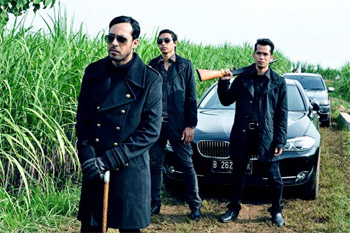 Sugar Cane (opening scene)
Sugar Cane (opening scene) When Evans wrote the script, he had the film's opening in mind. He imagined a wide shot of a vast green sugar cane plantation. Sugar cane plantations exist in several locations in the suburbs of Jakarta. Each plantation has a different harvesting period. Thus, the production schedule dictated which plantation would be used. The eventual selection was located four hours away from Jakarta.
Nightclub
The nightclub scene is where Prakoso gets trapped by Uco and Prakoso and must fight his way out while under attack by Uco's men from all sides. Some of the cinematography designed by Matt Flannery and Evans required a Jimmy Jib and the use of a dolly track. These requirements dictated the choice of nightclub location with a high ceiling and wide open space.
'The way we design our shots on The Raid 2 is very detailed and specific. We are always aware of the geography of a scene – both in terms of the choreography of fighting, blocking of the actors, but also in the camera positioning and movement. This means our location requirements are very detailed in where we need structures to be, and how the space is laid out. A lot of work is put into finding the location that best fits our needs, and in some cases we actually need to adapt the space. The nightclub specifically required extensive special equipment to achieve some long, complex camera moves, so we spent a lot of time visiting clubs and venues, measuring and walking through the camera's path to ensure we were able to get the shots as we designed them." (Matt Flannery)
After a protracted search for a suitable location, they chose a club in Bandung, a city three hours away from Jakarta. Given the complex choreography for the scene, the sling team required a certain amount of flexibility, especially to support Yayan when he had to jump off of a second floor balcony down to the dance floor. Open space that allowed for more freedom in terms of choreography and satisfied the complex technical requirements was a key aspect of this location. The filming at the night club took one week.
Snow Alleyway
In this scene, an assassin targets and kills Prakoso. Evans wanted to have snow in the scene for the aesthetic effect. He believed it would further heighten Prakoso's death by contrasting red blood flowing on clean white snow. The alley used for this shot is located in Gang Gardu jati, Bandung, not too far from the nightclub.
The Raid 2 – Score and Sound Design
The Raid's (original cut) score was done by Aria Prayogi and Fajar Yuskemal while The Raid: Redemption'S (U.S. and International release) was done by Mike Shinoda and Joe Trapanese. Both versions of the scores pleased the director, but on The Raid 2 he wanted to do something different. He wanted to be able to protect the work of the Indonesian artists. When the sequel film's production was announced, Joe Trapanese contacted him and showed interest in being involved in scoring The Raid 2.
'I spoke to the guys and decided to do a fusion composition where we would be able to bring in western and Asian influences into the score, and have them collaborate and create something unique" (Evans)
A connective element between The Raid: Redemption and The Raid 2 was very important. Trapanese, Prayogi and Yuskemal individually started to look to their previous work to see what they could bring back to the sequel: a certain melody, instruments or beats. Aria and Fajar came to Los Angeles to brainstorm with Joe and determine the feel they wanted for the score:
'It was intense, we had a lot of music to write and produce in only four weeks! I was very nervous about the collaboration at the beginning but quickly realised how much talent Fajar and Ogi have, and how quickly they can write. Once we began writing, it was mostly easy, just a lot of hard work! We did our best to help Gareth tell the story and bring proper energy to The Raid 2, and I found with three of us writing -sometimes together and sometimes separate - it was much faster and less challenging than if I was doing it alone. We wanted to keep the energy from the original while building on the new setting and the new characters of the sequel. That is why we began with the more intimate, mysterious, and tense cues. Through these moments we were able to help uncover the soul of the film, which informed our writing, especially for the action scenes". (Joe Trapanese)
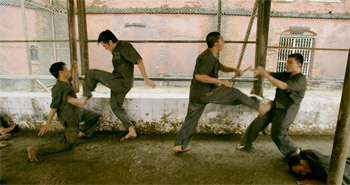 The three musicians have attempted to bring out different emotions depending on the scenes. The rhythm in the fight sequences is very dynamic in order to mimic the action. One scene in particular displays a Reog performance, an Indonesian traditional dance form. Music was recorded on set during the performance and slightly edited later so that it feels part of the world of the film. This is also evident in the fight between Rama and the assassin:
The three musicians have attempted to bring out different emotions depending on the scenes. The rhythm in the fight sequences is very dynamic in order to mimic the action. One scene in particular displays a Reog performance, an Indonesian traditional dance form. Music was recorded on set during the performance and slightly edited later so that it feels part of the world of the film. This is also evident in the fight between Rama and the assassin: For the silat vs silat fight, which lasts about seven to eight minutes, Aria wanted the score to have a traditional Indonesian feel to it. She used traditional Indonesian instruments such as Gamelan (Javanese small gongs) to give the sound an authentic cultural identity. (Gareth Evans)
Some more complicated sounds required extra work during postproduction. Foley and final mixing was done at Skywalker Audio Post in San Francisco.
The Raid 2 - Cinematography
The team focused its effort on balancing the old and the new. They wanted to make sure the audience recognised the familiar setting from the original, while exploring new parts of this environment. The sequel focuses on of Rama entering Jakarta's underworld, where the stakes are higher. The sequel was shot in cinemascope in order to provide a wider frame and give the story a more epic feel. The photography also explored a wider range of the color palette, using different lighting for each character. The film opens with similar tones as the first one and shifts as Rama enters the criminal organisation.
Shooting the film has been a learning experience for the whole team. On Merantau, the team learned to shoot martial arts. On The Raid: Redemption, they learned to shoot gunfights. And on The Raid 2 they went one step further, adding car chases to the mix.
On Merantau we felt we were focusing on the narrative drama scenes. For the action scenes, the takes were too long. We learned from that and fixed things on The Raid: Redemption. The Raid: Redemption had a majority of action scenes. We got to play a lot with camera angles and fluidity. Finding a new way to shoot action scenes. The Raid 2 is a much bigger project. What we chose to do is a combination of the two elements we learned from Merantau and The Raid: Redemption: dynamic, edgy and fluid camera movements, while at the same time knowing when to go for more classical and sophisticated compositions (when to use jimmy jib, steady cams and dolly track).Combining those two different styles was an interesting challenge in that respect. (Gareth Evans)
Because this was the first time a car chase of this scale was shot in Indonesia, a lot of time was spent on logistics. Unlike places like Hong Kong or the UK, where they have been shooting car chases for years, Indonesia did not have a particular set-up for this.
The production team had to build the structure itself to achieve specific shots: 'We had to have a shoot from the inside of one car going down a highway with the camera moving to another car straight away ,then have the back window to blown out for the camera to follow through the back window and out again. To do that, we discussed different combinations of computer-generated imagery, visual effects, green screens and so on. After a long discussion, we felt like we would be technically limited if we were to use too many special effects. In the end we decided to do it for real, meaning moving the camera from one camera operator to the other. This is something we had done on The Raid: Redemption when we went through a hole on the floor. It was done in a controlled environment and the only issue was the person passing the camera to another. But the difficulty here was to pass the camera between moving cars on a highway. It was risky shot, but thankfully after a number of takes it was done well". (Gareth Evans)
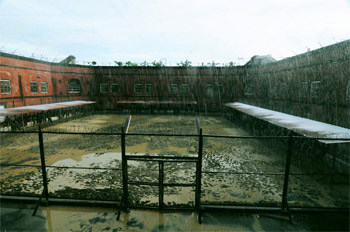 Camera moves were carefully integrated into the martial arts choreography. The fighters' moves are choreographed to the slightest detail, and so are camera movements. Camera angles are designed before the shoot, so it never feels like the camera interferes with the action. A constant mantra during shooting was to highlight the actors' performances.
Camera moves were carefully integrated into the martial arts choreography. The fighters' moves are choreographed to the slightest detail, and so are camera movements. Camera angles are designed before the shoot, so it never feels like the camera interferes with the action. A constant mantra during shooting was to highlight the actors' performances.
'The brothel scene is one of my favourite shots, when a character gets thrown through a window. The camera starts low on the ground and follows him through his jump. It ends up getting upside down. As he rolls over to get up, the camera rolls with him and swings around to catch Uwais jumping through a window. It comes to a close-up of his feet and then follows him. It was a complicated shot. What makes it even harder is that we had to do this without rigging. We had two camera operators controlling the camera. It's not just about getting the movement right. You also have to clear the path or we would have seen one of the camera operators at some point in that scene. Overall it was a great team effort to get it executed correctly." (Gareth Evans).
The Raid 2
Release Date: March 28th, 2014
MORE





